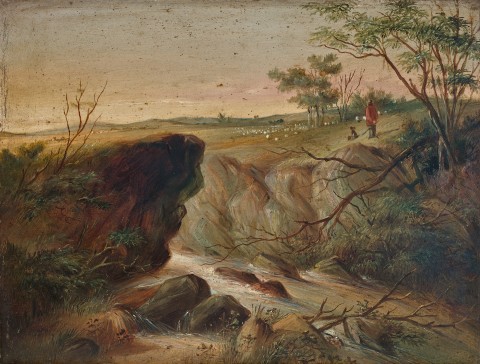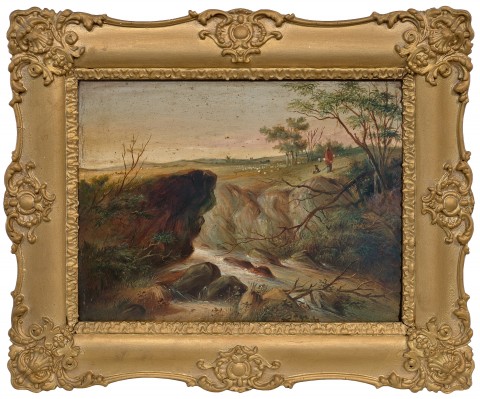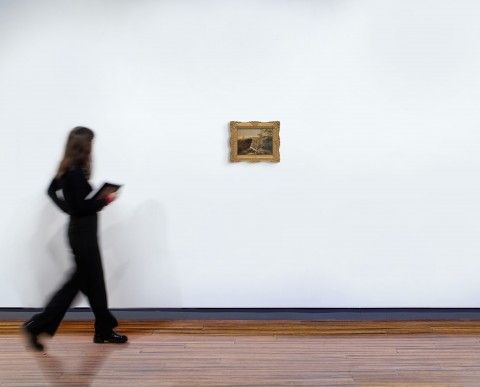(1818 - 1880)
S.T. Gill
On Rocky Creek near Fryers Creek, 1852
oil on compressed card
Arthur H. S. Piggin, Melbourne, acquired c.1879
Thence by descent
Private collection, Melbourne
Thence by descent
Private collection, Melbourne
Recognised as one of the most engaging and observant artists of Australian colonial life, the young Samuel Thomas Gill arrived in South Australia, aged twenty-one, with his parents and siblings in December 1839, only three years after Adelaide was founded on the lands of the Kaurna people. Having received training in Plymouth and London, within three months Gill was advertising his artistic availability. In his advertisement he proclaimed his willingness to capture ‘correct likenesses’ of individuals, horses, dogs, local scenery and residences ‘sketched and… suited for home conveyance’, to record and inform distant family and friends of life in Australia.1 In addition to these genres, Gill travelled to townships around the colony, undertaking commissions including recording the early copper and silver mining industries, and participating in exploratory travels. By the mid-1840s his lively art was being displayed in Britain to entice immigrants and investment. Failing to sustain an income, in 1852 Gill joined the hopeful hordes flocking to the newly discovered goldfields in Victoria, his art appearing increasingly in printed formats, furthering his growing reputation. He is now remembered as the quintessential artist of the Australian gold rush, capturing with his deft line the tension, boredom, humour, celebration and desperation of that tumultuous period.
Prolific throughout his life, Gill is well-known for his fluid and colourful watercolours, pencil sketches and often entertaining lithographs. However, his oil paintings are rare, with these being among the few known examples. Significantly, the provenance records a direct line from the artist to the current owners. Arthur Henry Sturgeon Piggin arrived in Melbourne in early 1869, aged twenty-two, continuing in his father’s trade as a draper (a fabric merchant). On 7 September 1876, Arthur married Jane (Jeanie) Reid McNaughton at the West Melbourne Church, with whom he subsequently had seven children. Piggin had ‘apparently formed a close friendship with Gill’ during the intervening years, with Gill presenting one, if not more paintings, to the couple on the occasion of their wedding.2 In 1958, the Piggin family donated Mt Gambier, South Australia, 1852 to the National Gallery of Victoria, and descendants now offer an additional three paintings (lots XX and XX).3
This pair of paintings, matching in proportions, show locations to the west of Melbourne that Gill is known to have travelled to. A spacious pencil study in the State Library Victoria collection titled ‘Mt Emu from S.Y. Hill / 6 & 7 miles’, and initialled and dated ‘2 May 1855’, tallies closely with the pen and ink inscription on the reverse of ‘Mt Emu from Stock Yard Hill / 1855’.4 In both sketch and painting, we look south-east across Black Lake towards the tapering curves of Mt Emu on the horizon. In the oil painting, however, Gill has included a foreground narrative of Aboriginal people, clad in a possum-skin cloak and, possibly, blanket, gazing across the plain. Given the rapid pastoral expansion of Victoria’s Western Districts and the violent impact of British invasion upon the Wadawurrung people, it is likely that Gill’s inclusion of such figures drew upon his past encounters with Aboriginal people from various countries.
Fyansford, at the junction of the Barwon and Moorabool Rivers to the west of Geelong, appeared a number of times in Gill’s art, best known in two lithographs in his portfolio Diggers and diggings of Victoria as they were in 1852, published in Melbourne in 1855. In the print On the Barwon near Fyansford Geelong, Gill shows cattle calmly grazing by the river’s edge among scattered gum trees, while in the closely titled On the Barwon above Fyanford Geelong, he has taken a high vantage point, showing cleared and planted land on the far slopes of the river valley.5 The oil painting shows another viewpoint, with two men perusing the calm scene, the stump and felled tree that frames the foreground implying the impact of settlement as much as the presence of the cattle scattered up the hillside.6
Despite the differences inherent in the media, the deft application of paint, notably in the thin branches and the feathery depiction of grass and leaves, the crisp atmospheric tonality, and the somewhat awkward forms of the Aboriginal people correspond closely with Gill’s noted watercolour and drawing abilities. The paintings are on prepared compressed millboard made by the well-known London-based art supplier James Newman Ltd (its stamp visible on the reverse of the boards) and they remain in their nineteenth-century frames.7 Although Gill’s distinctive initials, with which he regularly signed his work, are absent from the four paintings, further research into the contemporary inscriptions on the reverse of the boards may prove fruitful.8 While fresh material in an unusual medium for an artist known to be widely copied in his own time must be carefully examined, the known family friendship with Gill, the correlating style and subject matter, and the freshness of application – unlike that of any known painter/copyist at that time – all accord with these being rare examples of Gill experimenting with and exploring the medium of oil paint.9
The author would like to thank Gerard Hayes for his assistance with this entry.
1. South Australian Gazette and Colonial Register, 7 March 1840, p. 1, see: nla.gov.au/nla.news-article27441257 (accessed July 2025)
2. See Appleyard, R., Fargher, B., and Radford, R., S.T. Gill: The South Australian Years 1839 – 1852, Art Gallery of South Australia, Adelaide, 1986, cat. no. 30, p. 58 and n. 15, p. 117
3. See Mt Gambier, South Australia, 1852, oil on board, NGV 84 – 5 at: https://www.ngv.vic.gov.au/explore/collection/work/5619/ (accessed July 2025)
4. See Mt Emu from S.Y. Hill / 6 & 7 miles, 1855, pencil, SLV H4591 at: http://handle.slv.vic.gov.au/10381/303587 (accessed July 2025)
5. See The diggers and diggings of Victoria, 1855, NGV 2011.291.1-25 at: https://www.ngv.vic.gov.au/explore/collection/work/100164
6. The detailed drawing Fyansford, Barwon River, Geelong, c. 1854, SLV H4318, shows the bridge that replaced the ford, which opened in 1854, see: http://handle.slv.vic.gov.au/10381/290240 (accessed July 2025)
7. See National Portrait Gallery, London ‘British artists’ suppliers, 1650 – 1950’ at: www.npg.org.uk/collections/research/programmes/directory-of-suppliers (accessed July 2025)
8. The Mt Emu inscriptions noted above warrant comparison, together with Arrival of Geelong mail (Main Road Ballarat), Art Gallery Ballarat 1978.133, inscribed with the same date, see: https://www.artgalleryofballarat.com.au/explore/the-collection/search/2649 (accessed July 2025)
9. A group of six oil paintings, sized 14 x 23 cm and marked with Gill’s initials, were sold through Leonard Joel’s, Melbourne, 20 April 1972, and subsequently. See for example: https://www.bonhams.com/auction/21294/lot/76/st-gill-1818-1880-governmen... (accessed July 2025). These are crude copies after Gill’s Diggers and Diggings lithographs, 1855.
ALISA BUNBURY


